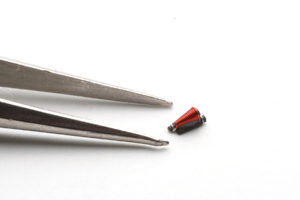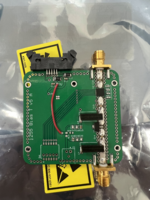Zebxcore
Newbie level 6
Hello all,
I am fairly new into RF applications but I got some of the basic theory down. I have my first task for my company: Design a bias t with a bandwidth of 100MHz to 1GHz or higher (I was thinking 4GHz so I can use it for other testing purposes) with as low as an insertion loss as possible, 15V DC. But, this is my first time designing something that is so hard to get some knowledge on from books/websites/papers. Here is what I learned/know/done so far:

This is the basic design I made basing myself on one of the bias T's from mini-circuits (10MHz - 4.2GHz). However, L1 seemed like a ferrite bead rather than an inductor (I could be wrong). The values of the inductors as well as the decoupling RC circuits go from bigger to smaller from DC to RF path (L5 > L4 > L3 etc.).
I have two big questions and they are as follow:
Edit: bad image, changed it. Added some more info
I am fairly new into RF applications but I got some of the basic theory down. I have my first task for my company: Design a bias t with a bandwidth of 100MHz to 1GHz or higher (I was thinking 4GHz so I can use it for other testing purposes) with as low as an insertion loss as possible, 15V DC. But, this is my first time designing something that is so hard to get some knowledge on from books/websites/papers. Here is what I learned/know/done so far:
- I am using a 50ohm input as well as output system.
- Since my bandwidth is pretty wide, I learned that using cascaded inductors at different resonant frequencies helps reducing parasitic capacitances across the design.
- DC blocking capacitor's resonant frequency should be far away from your signal frequency (Also applies to the inductors)
- Coupling some resistors in parallel with the inductors helps take some of the parasitics as well.
- Decoupling RC circuit in between inductors to help keep each inductor's SRF on check.
This is the basic design I made basing myself on one of the bias T's from mini-circuits (10MHz - 4.2GHz). However, L1 seemed like a ferrite bead rather than an inductor (I could be wrong). The values of the inductors as well as the decoupling RC circuits go from bigger to smaller from DC to RF path (L5 > L4 > L3 etc.).
I have two big questions and they are as follow:
- I am having issues picking the right inductance. Do you have to do trial and error for one inductance then split it into 3-4 inductors in series or pick an inductor value for each inductor? What about ferrite beads?
- For my given bandwidth, what would be the difference of an inductor having 90MHz SRF and a 1300MHz SRF? If most of my usage of the bandwidth is found between 200MHz and 900MHz I know a SRF of 1200MHz would affect me at or around that range, but would it be noticeable enough?
Edit: bad image, changed it. Added some more info
Last edited:


